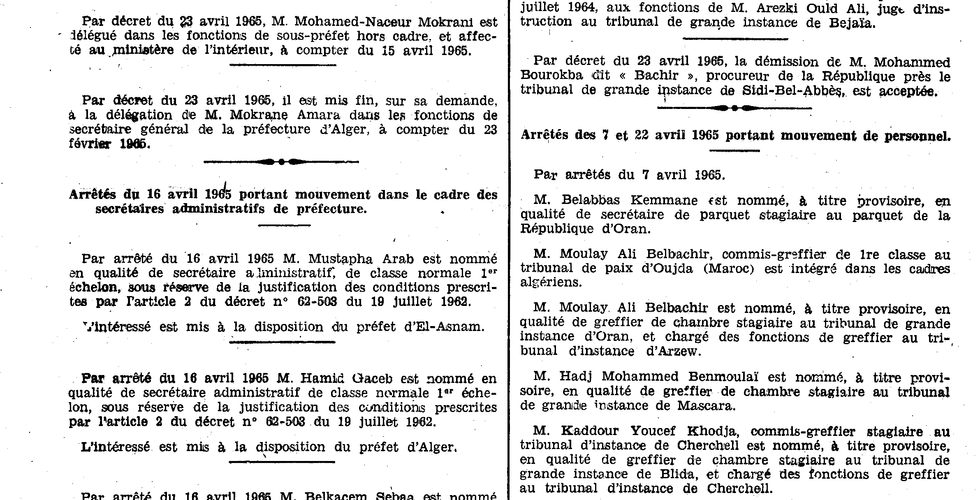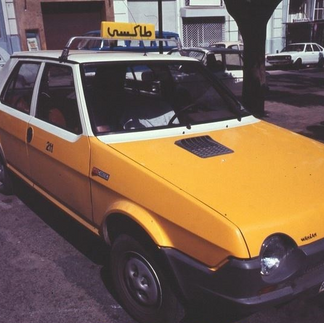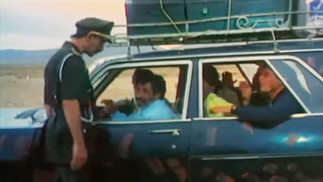The History of Public Transport in Algeria (7/10): the Taxi
- COCKPIT
- Dec 5, 2024
- 8 min read
Updated: Mar 23
The first internal combustion engine taxi capable of carrying up to four passengers appeared in Paris in 1899. In 1904, Louis Renault launched the first two-cylinder model in Paris, specifically for taxis.
During this period, the taxi used in Algeria was the corricolo (a horse-drawn carriage driven by a coachman). It served the municipalities of Algiers, St-Eugène, El Biar, Bouzaréah, Bir Mourad Raïs, Kouba, Hussein-Dey, and Maison-Carrée. Its services could be hired for a half-day (6 hours, 11 francs) or a full day (12 hours, 20 francs). The car traveled at a speed of 10 km/h on flat terrain and 7 km/h uphill, with a quarter-hour stop every 10 km.
1908, in Algiers, the first car taximeter in Algeria appears.

In 1912, the city of Oran tested its first self-driving taxis, like those used in large modern cities.
A personal initiative of Mr. Serviès, the Oran industrialist,
These Oran taxis were in every way similar to those of the great city of Paris. Completely closed in winter, in the form of coupés, they could, in summer, offer all the advantages of open-top cars. Their elegant appearance made them easy to use. There was no doubt that the city's elegant ladies would adopt this means of transport for their visits or long walks around Oran.
Those who adhered to the motto "time is money" would certainly use this mode of transportation, which would allow them to complete a number of errands they could not do without the help of taxis. This new improvement added to the beautification of the beautiful city of Oran, which would gradually become a reduced image of the great French capital.


In Algiers, in 1922, the first internal combustion taxi company, called S.A.T.A. (Société Algérienne de Transport par Automobiles), appeared.
Initially, these were 10hp Landaulet Delahaye taxis, then Tropédos Delahaye de Luxe, certainly much more luxurious and much more comfortable than anything else put on the road in France, including Paris.
In 1924, a major strike by S.A.T.A. taxi drivers over their wages plunged the company into a financial crisis.
In 1925, S.A.T.A. transferred the operating rights for its taxi branch to the Société Algérienne des Taxis Citroën, operating only for Algiers. Naturally, this led to the appearance of Citroën taxis with their B2 Laudelet model.

In 1925, a second taxi company was set up in Algiers, the Société Algérienne des Taxis Citroën, with 100 luxury 5-seater taxis.

In 1925, the first taxi group was created, G.T.A. (Algerian Taxi Group), following previous taxi strikes.

In 1960, 528 taxis were circulating in Greater Algiers.

After the independence of 1962, in its policy of rewarding veterans of the Algerian war, by ensuring them a better future, the state regulates the taxi driver activity by awarding taxi licenses exclusively to holders of a moudjahidine (veteran) license, former death row inmates of the Algerian war and their beneficiaries, this action is part of a series of advantages for them in gratitude for the service and sacrifice rendered to the Algerian nation.
These famous mujahideen licenses are nowadays decried and it is requested to replace them with administrative licenses, because the remaining number of beneficiaries is decreasing from year to year and the age of the latter logically exceeds the tolerable in terms of conduct, but it is politically difficult to touch the consecrations of those who liberated Algeria even though we are in a period of transition where the youth must take over throughout the country.
However, in 2021, a first opening was made by the Minister of Transport, Aissa Bekkai in collaboration with the Minister of Mujahideen and Rights Holders, of the taxi license file. A measure that seems to satisfy taxi drivers.
The Coordination of Taxi Drivers of the Wilaya of Algiers (CCTWA) welcomed this decision by the Minister of Transport, which thus resolves "one of the great and old problems of the sector".
"We are not calling for the cancellation of these mujahideen licenses, we respect them and will always pay tribute to them. But we are asking that there be, at a minimum, some regulation and that the administration clearly define the rights of tenants and rights holders and control the prices of these licenses," confided Sid Ali Aït L'Hocine, president of the CCTWA, stating that the scarcity of these licenses hinders their profession.
"We are tired of traveling every time and looking for the homes of these beneficiaries. We have a lot of difficulty finding the holders of these licenses, without forgetting that with age, the mujahideen are becoming increasingly rare," added the president of this union, affiliated to the UGTA, which has more than 16,000 members.
The announcement by the Minister of Transport is "good news," he said, saying that he is thus waiting for an invitation from the minister to dialogue to discuss all the proposals and concerns of taxi drivers.
In fact, the CCTWA advocates for more licenses and control, by setting their price by the administrations concerned (the services of the APC and wilayas), so that there is more transparency, recalling that he had sent several letters in this sense to the authorities concerned including the Prime Minister and the President of the Republic, in order to find a solution to their request.

Referring to the problems encountered regarding the licenses of the mujahideen, Sid Ali Aït L’Hocine cited what he calls “blackmail” by some holders and beneficiaries of these licenses who rent them at “unusual prices” to taxi drivers.
Legally, the license of the mujahideen is rented at 1,000 DA/month, an amount fixed and mentioned on the contract form, or 12,000 DA per year that the taxi driver must normally pay in return for benefiting from this document, essential to practice this profession.
However, some beneficiaries of these licenses “force tenants to pay illegal and larger sums under penalty of having this document withdrawn,” denounced the president of the CCTWA.

He stressed that many taxi drivers had to, in spite of themselves, abandon this profession because of these problems and constraints, adding that faced with the reduction of these mujahideen licenses - this license has a validity period linked to the life of the beneficiary -, many taxi drivers find themselves forced to practice clandestinely in order to provide for the needs of their families.
"The law requires taxi drivers to rent a Mujahideen license, otherwise the transport department will not issue them a purple card to practice legally," said Sid Ali Aït L'Hocine. The purple card is valid for only one year. "To renew your purple card, they require you to bring the certificate of life of the Mujahideen or beneficiaries. Something done by the latter in return for an unregulated sum unfortunately. Fixed by law at 1,000 DA, the right to operate a Moudjahid license is sold for between 3 and 6,000 DA in the capital. In some western wilayas, it even reaches 10,000 to 15,000 DA," he said.
The CCTWA has thus called for reforming the granting of these licenses in order to impose more transparency and avoid any opacity and practices detrimental to operators in this profession.
This aside alone sums up the great malaise of taxi drivers and users who pay the price. But it is not the only one, the lack of vehicles and parts is another, which pushes taxi drivers to no longer use their meter to set the price of the trip, but to have pre-established rates much higher than that of the meter. Another misdeed, taxi drivers no longer exercise their function to take the customer to the requested place, but set their own route at their convenience and what was originally an individual service, taxis become collective to the great dismay of users. This anarchy has opened the way to clandestine taxis which offer more flexible services.

In 2012, a regulation of the taxi activity was made, the decree, published in the official journal No. 33, defines as "taxi" any motor vehicle authorized to provide the transport of passengers and their luggage for remuneration. This transport is carried out by three types of taxis (individual, urban collective or non-urban collective).
It is specified that individual taxis are "services carried out on demand without limitation of journey in a vehicle with four (4) seats, not including that of the driver".
Urban collective taxis carry out a fixed route while non-urban collective taxis carry out intercommunal and inter-wilaya routes in rental divided by a vehicle with 8 seats. This service is reserved for individuals and taxi companies founded by individuals, both of Algerian nationality.
As for the rates applied, they are set by the regulations in force, the text further emphasizes. In addition, operating a taxi service is subject to obtaining an authorization granted by the Ministry to individuals who must in particular be at least 25 years old, have full ownership of a compliant vehicle, provide guarantees of morality and not be subject to an incapacity to practice following a conviction.
For legal entities, it is imperative to provide proof of insurance taken out against the financial consequences of professional civil liability, have a fleet of at least 10 vehicles and provide proof of a call center per transmitter.
Furthermore, vehicles intended for this activity must be equipped with a horokilometric measuring device called a "taximeter" in good working order which indicates the rate applied and the price to be paid.
The challenge is to apply it!

In 2015, the operation to standardize the colors of taxi vehicles in the wilaya of Algiers (which was already in the 70s/80s: yellow and green, then abandoned) in orange and black since, was immediately canceled with that of the obligation to wear a uniform for taxi drivers, under the pretext that the change of color will affect the market value of their vehicle, this demonstrates the degree of investment of taxi drivers.
In 2016, the entry into force of a new specification concerning taxi drivers, the situation still seems the same and nothing has changed in their behavior or in their presentation. For the old ones, a wind of nostalgia reigns.

In 1987, the state opened the door to private taxi companies and public transport in general with the bus as we presented in the previous article on the bus. Unfortunately, and unlike the bus, the experience was not a success with the abandonment of activity of the latter. Many are turning even more to clandestine taxis, illegal, but tolerated.
*Extras from the movie The Clandestin (Taxi El Makhfi) 1989
It was in 2017 that the first VTCs (chauffeur-driven cars) appeared, and with them a new era for taxis began, despite the fact that the activity was decried as illegal by the taxi drivers' union. This will not change anything since the development of VTCs is booming thanks to an interpretation of the law that circumvents the taxi license requirement by placing these companies as service providers that connect the customer with people in charge of transporting them, thus placing the responsibility directly on these VTC drivers who incur all the legal risks.

The authorities have planned a solution but it does not seem complete. In this regard, the new law on self-employment currently being debated at the APN will allow drivers to have a status.
The text of the law in question includes VTC application drivers in the list of beneficiaries of the self-employed status in the same way as developers of websites and web applications, managers of social networks and a certain number of new professions that have appeared with the technological revolution.
The next article will be about the tramway.



















































